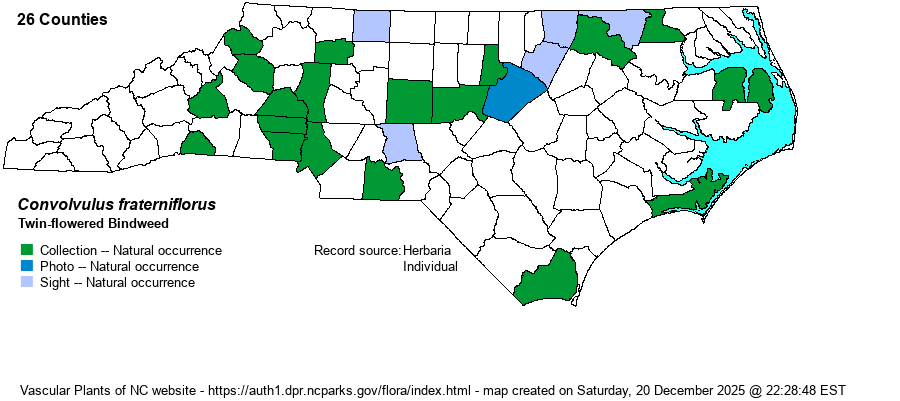| Author | (Mackenzie & Bush) Mackenzie & Bush | |
| Distribution | The former Calystegia sepium from RAB (1968) has now been split out into several species, all now in the genus Convolvulus. Thus, many specimens labelled as C. sepium have probably not been annotated or moved into the new species folders at herbaria. The website editors have mapped records in SERNEC listed as Convolvulus fraterniflorus and as Calystegia silvatica var. fraterniflora; these fall mostly in the Piedmont, but also widely scattered in the Mountains and Coastal Plain, if correct in these latter regions.
Weakley (2024) shows the range being somewhat northern, ranging south to SC, northern GA, and AR. | |
| Abundance | Though Weakley (2024) shows the species as "rare" in the Piedmont and Coastal Plain, and absent in the Mountains, on his range map, the specimen data suggest that the species is not truly rare in the Piedmont. It is best stated as "probably uncommon" in the Piedmont, and rare in the adjacent northwestern Coastal Plain. The website editors suggest a State Rank of S3? and no watch list at the present time. | |
| Habitat | "Thickets, roadsides, fields, streambanks, disturbed areas" (Weakley 2024). | |
| Phenology | Blooms from April to September, and fruits shortly after flowering. | |
| Identification | Members of the former Calystegia sepium (now Convolvulus) complex -- C. americanus, C. fraterniflorus, C. binghamiae, and species 2 -- all are herbaceous vines that range to about 12 feet long or more, and they are also strongly twining. The large alternate leaves are mostly arrowhead-shaped to triangular, with long tips and heart-shaped or more often squared-off leaf bases. Flowers are mostly in the middle and upper leaf axils and are quite large, funnel-shaped, about 2-3 inches long and across, either white or pink with yellow deep in the throat. C. fraterniflorus differs from the other three by the "margins of the bracts immediately subtending the flower overlapping > 1/2 their length; bracts inflated at base (saccate), the apex usually obtuse; flowers 1-2 per axil" (Weakley 2018) -- versus "margins of the bracts immediately subtending the flowers overlapping at the base only or not at all; bracts mostly flat (or often keeled), the apex usually acute; flowers 1 per axil" in the others. Of this latter group, only C. binghamiae has white flowers, whereas C. americanus and C. species 2 have pink flowers. These latter two are separated by "Leaves with basal lobes rounded or with a single angle, or if with 2 angles then not spreading; plant glabrous or commonly pubescent to tomentose on stem" (Weakley 2018) for C. americanus -- versus "Leaves with lobes with 2 angles, spreading; plant glabrous" for C. species 2. In summary, this should be the only member of the group found in the Piedmont, and it should be identified by its large white flower with yellow in the throat. Where it may overlap in the Coastal Plain with C. limnophilus, which also has white flowers, see if it has two flowers in an axil (which only C. fraterniflorus has); otherwise, you need to check the bracts of the flowers. | |
| Taxonomic Comments | See Distribution. This taxon is not recognized by NatureServe.
| |
| Other Common Name(s) | Shortstalk False Bindweed | |
| State Rank | [S3?] | |
| Global Rank | G5TNR | |
| State Status | | |
| US Status | | |
| USACE-agcp | | |
| USACE-emp | | |

